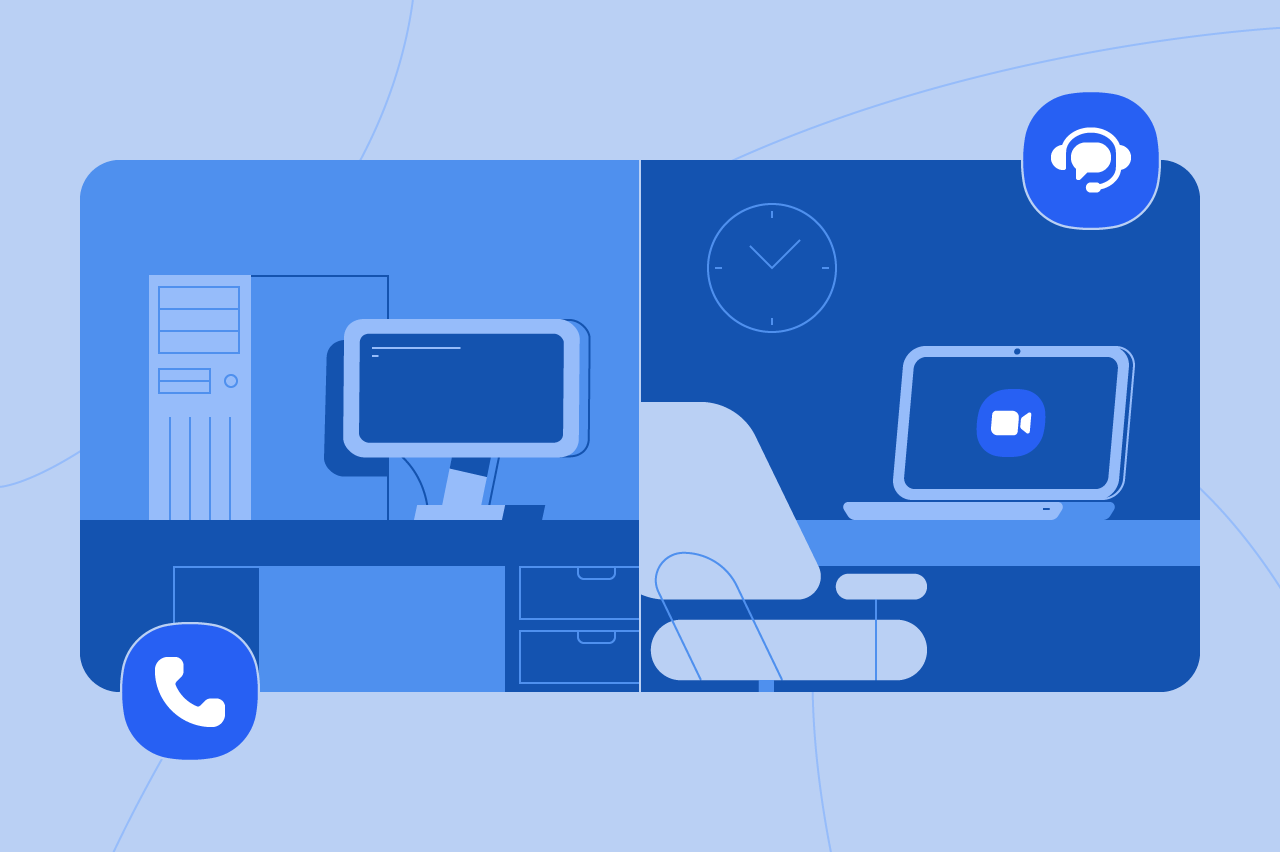
What is a cloud contact center and how to choose the best one
Explore what a cloud contact center is and how it's different from traditional contact center solutions. Explore features and tips to choose the right software.
Updated on February 13, 2025
Published on September 29, 2023


Do you know the number of people currently subscribed to your service and how that differs from a month, a quarter, or a year ago? Understanding the average churn rate for subscription services and how your churn rate is trending is vital to keeping your business on track.
What is subscription churn and how do you reduce it?
Churn is the term used for the rate at which a subscription business loses subscribers. Churn can be voluntary, for example, when the subscription doesn’t meet customer expectations and the customer cancels it. However, your business can also experience involuntary churn, for example, if the account used for recurring payments no longer has sufficient funds.
Churn can also be a financial metric. Revenue churn is the percentage of subscription dollars a subscription company loses in a specified period or the contract value of existing customers a company can keep.
Calculating—and minimizing—churn rate is crucial to any subscription company. As you know, customer acquisition is more expensive than customer retention. For Software as a Service (SaaS) companies, the cost can be five times as much. Therefore customer retention is key to your growth strategy. If you are losing customers to churn as quickly as you are acquiring new ones, your operating costs will be higher at the end of the year from where you started in terms of monthly revenue.
If you can keep churn rates under control by maximizing customer satisfaction and effectively managing accounts, you can operate more profitably and see more growth.
Churn rate is an important key performance indicator (KPI) for subscription businesses. It’s a good idea to calculate your business’s churn rate today to see how you are faring compared to competitors in your industry. However, it’s also important to track churn rate over time. Even a slight change can indicate that customers are taking their business elsewhere, and you need to act quickly to determine the root causes to understand why.
Additionally, if your involuntary churn rate is increasing, it may be time to put systems in place, such as an automatic account updater to keep payment card data current and decrease declined transactions.
When churn is voluntary, it’s vital to understand the cause and make changes to minimize it. Segments of your customer base may churn for a number of reasons, including the following:
Churn rate often correlates directly with the quality of service you provide. Evaluate your performance with regard to wait times, issue resolution, and other metrics to ensure you’re doing all you can to maximize customer satisfaction and, therefore, customer retention.
A pricing increase can lead to a bump in your monthly churn rate if your customer base is highly price-sensitive. Monitoring revenue churn will help determine whether your customers see the value in your offering at the price you’ve set.
Sometimes you can trace churn back to external factors, such as a competitor launching a similar product or a negative ad campaign about your brand. Keep an eye on all factors, both inside and outside your operation, that can impact churn.

Calculating your churn rate can be relatively simple. Use the below formulas to help:
Customer churn rate:
[lost customers during a period]/customers at the beginning of the period.
Multiply the result by 100 to get the percentage. You can see from the formula that if you don’t lose any customers, churn rate would be 0%. If you lose half of your customers, churn rate would be 50%.
Revenue churn rate:
[(MRR at the beginning of the period -MMR at the end of the period) – MRR from upgrades during the period]/MRR at the beginning of the month
Again, multiply the result by 100 to get the percentage. Note with both churn formulas, that it’s possible to gain subscribers and revenue. In this case, you would have a negative churn rate.
On the other hand, you can adapt churn rate calculations specifically for involuntary or voluntary churn, use averages, or compare churn during various timeframes. Using different calculations can provide you with more insight into customer satisfaction and why churn occurs.

When you have calculated your churn rate, inevitably, you’ll want to know how your business stands up against your peers and competitors. Start with these benchmarks for comparison:
Subscription billing solution provider Recurly reports that the average churn rate for subscription services in the B2B software market is 3.36% (voluntary churn). Churn for B2C SaaS businesses is slightly higher at 4%. Involuntary churn is lower at 1.19% for B2B software and 1.70% for B2C software.
Statista reports that the average churn rate in the U.S. for streaming services was 37% in the second half of 2022. Statista also points out that there are generational differences, with younger consumers more likely to churn.
Meal kit businesses have one of the highest average churn rates. Bloomberg reports that leading meal kit companies have customer retention rates less than 20%.
Shopify reports that the average churn rate for subscription services via e-commerce is about 5%.
Gyms can lose up to 50% of their customers each year, with elite groups able to achieve only 30% churn.
Business of Apps reports that the mobile app customer lifecycle is complex, with different rates for day 1 vs. day 30 and between iOS and Android users. Overall, average retention across 31 mobile app categories was only 25.3% on day 1 and fell to 5.7% by day 30, therefore, representing high levels of churn.

Here are some key guidelines for improving your subscription retention rate and increasing the lifetime value of your customers:
New customers often churn because they’re not impressed by a company’s customer service. Miscommunications about items, unexpected charges, delayed shipping, long call hold times, unhelpful support staff, and delayed or nonexistent email support are all elements of poor customer support that can damage customer relationships and lead to poor customer retention.
In order to boost your customer subscription retention rate, make sure that you have built strong processes for managing customer expectations, including clear communications around purchases, shipping, and returns; and access to a best-in-class customer support team for customers who require extra attention.
Using support as an outlet to engage customers will also lead to positive effects. Is a customer asking about tracking a delayed package? Provide a discount by adding a few extra days to their monthly billing cycle. Notice a customer is dissatisfied with an order? Provide them with a free offer. Spending the time and resources to create these small moments will always be worth it when the alternative is losing them as a customer. Invest in customer support technologies and initiatives that will deliver excellent customer service, increasing your customer retention rate.
Good customer support is one thing, but excellent customer service requires even more attention to detail. Providing more personalization in customer experiences can reduce the churn epidemic in subscription businesses. Research from McKinsey & Company on e-commerce subscriptions found that 28 percent of customers said that a personalized experience was the most important reason for continuing to subscribe.
Providing these customer experiences doesn’t need to be complicated. Delighting customers with personalized offers, handwritten notes, and other simple recognition of their loyalty to your brand are all great first steps to showing your customers you value and appreciate them. You can also make use of marketing automation technology that responds to their digital body language, sending them highly relevant content based on what they’ve shown past interest in. Creating these moments that matter for your customers—and celebrating that they chose your business—will keep them happy.
Encourage your customers to stay engaged and become brand advocates by providing generous incentives for remaining loyal to your brand and performing certain actions. The makeup subscription box service Ipsy, for example, gives loyal customers “points” for each month they receive a box, as well as the chance to receive extra points by taking actions such as leaving product reviews and referring Ipsy to friends. These points can be redeemed for free monthly bonus items.
A high-quality customer loyalty program can increase your customer lifetime value substantially. Rather than spending heavily on customer acquisition, focus on building loyal customers who’ll advocate for your brand.
Pay attention to what your customers say about your brand — directly to you or on social media or external review channels. Are you meeting or exceeding customer expectations, or are you falling short? Pay close attention to trends in both customer complaints and praise to build a roadmap for improving your products and customer support throughout the customer lifecycle.
Use your CRM to track subscribers down to the individual level to understand patterns that impact customer retention and loss. For example, how many subscribers skip two months of shipments and then cancel altogether? Can you develop customer retention strategies to re-engage with these customers by providing them with a special promotion or exclusive new product for their next shipment? Can you offer them personalized customer support to help them find what they want?
Pay close attention to those customers who seem on the verge of disappearing — it will be much easier to win them back while they’re still active in your customer base than after they’ve opted out.
Once you’ve implemented new customer retention strategies, how can you track their success? Pay attention to changes in metrics over time, including the number of customers who maintain their subscription for 30, 60, or 90 days; their average spend; and how many new customers each existing customer refers. If you’ve worked hard to optimize the customer experience, you should begin to see a substantial boost to your bottom line.
Follow your progress over time and adapt your strategy to optimize for higher customer retention, such as testing out different types of follow-up email offers to lapsed subscribers to see which offer has the highest success rate, then building on those successes.

The negative effects of churn on subscription businesses can be devastating. The most obvious problem is that you’re no longer gaining value from a loyal customer, and worse, you’re losing future lifetime value that could’ve been gained by keeping that customer.
Choosing the best customer support tools can provide you with the data, visibility, and capability to intervene with personalized service to ensure high customer satisfaction and minimize the risk of churn.
A high average churn rate for subscription services doesn’t need to be a plague in the industry. With sights set on better customer experiences and the right customer retention strategies in place, you’ll keep churn to a minimum.
Want more tips for increasing customer retention and increasing satisfaction? Contact us to learn about our customer experience solutions, including Zoom Contact Center, Zoom Virtual Agent, and our Workforce Engagement Management tools.